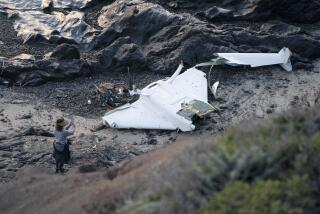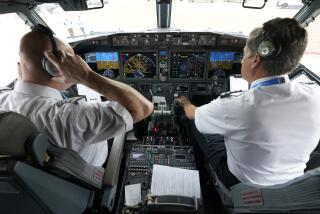FAA’s Hands-Off Policy on Ultralights Called Into Question
ALBUQUERQUE, N.M. — Witnesses recall hearing an engine sputter and “a loud pop”--the sounds of William Donaldson’s ultralight airplane stalling above the forest, spinning into a nose dive and crashing.
Donaldson loved these single-seat aircraft, and no wonder. Under the right conditions, they offer bird-like flight--you move slowly, putt-putting aloft with clear, wide views uncluttered by panels or propellers.
Under the wrong conditions, you can go straight down.
That’s what happened Oct. 29, 1996, to Donaldson--a 48-year-old pilot from Waynesboro, Va., who did not have a pilot’s license, flying a home-built plane that had never undergone a safety inspection.
Neither is required by the Federal Aviation Administration. Despite Donaldson’s death, FAA aviation and flight inspector Bill Cook said the regulations are “working to perfection.”
Simply put, it has been the FAA’s position that if these folks are foolish enough to risk their lives in these tiny planes, the federal government will not get in the way.
“There’s been no one injured or killed, to our knowledge, as the result of an ultralight vehicle crash” who wasn’t on board, Cook said. “In that respect, these may be the best rules we’ve ever written.”
An AP computer-assisted review of FAA and National Transportation Safety Board databases, local law enforcement records, ultralight organizations and news accounts found that Donaldson was one of about 30 people to die during the last year in an ultralight in the United States.
Ultralight makers, insurers and enthusiasts say that if the FAA would tighten its rules, the number of deaths could be reduced. At their urging, the agency plans to consider a proposal that, in essence, would establish a new classification of ultralights. They would be larger and faster, and would require some pilot training and safety inspections.
“It’s the American dream that we can ride off into the sunset, even if it’s over a cliff. These new rules wouldn’t prevent that, but they would give a guy more opportunities for training,” said Tom Gunnarson, who chairs the committee chairman and is director of safety and training for the U.S. Ultralight Assn. in Frederick, Md.
The FAA estimates that, nationwide, there are 15,000 to 40,000 ultralights--single-seat aircraft with parachute-type wings, a long, narrow aluminum tube for a body and a motorcycle-sized engine that fires up with a pull-string starter.
FAA rules for ultralights prohibit passengers; require pilots to always be able to see the ground; forbid flights in darkness or over congested areas or controlled airspace; and limit fuel to 5 gallons, speed to 55 knots (63 mph), and weight, unloaded, to less than 254 pounds.
But the planes are not registered. And when people die, no official records are kept.
In 1985 the NTSB issued a warning that ultralight rules had “serious deficiencies” and urged the FAA to implement tougher standards.
The FAA did not.
“The result of the FAA’s failure to act? More deaths, stifling a potentially very nice industry and damage to general aviation as a whole,” said Chuck Hubbard of EMCO Insurance Co. in Frederick, Md.
The FAA disagrees.
“We feel like we’ve got a pretty good system in place at this time,” said Hank Price, an FAA spokesman in Washington, D.C. “They’re not putting anyone in harm except for themselves.”
Tell that to Raymond Dale Tappe.
Tappe, 64, of Shreveport, La., took a jaunt in his fixed-wing Aeronca--not an ultralight--last Oct. 12. He was 200 feet in the air, traveling about 80 mph and making a final approach to a local grassy airfield when something smacked his plane’s tail, sending it straight down.
Tappe grabbed the controls but “the controls didn’t work.”
With incredibly quick thinking and deft engine control, Tappe pulled his “old tail-dragger” back up, brought it around and landed.
It was only then that he spotted David Hamilton Hollifield, 59, of Shreveport, climbing out of his ultralight, which was hung up in a nearby tree. Hollifield’s ultralight had rolled over on top of Tappe’s plane.
Neither man was injured. Amazingly, they are friends, and Hollifield, a novice pilot, had recently bought his ultralight from Tappe.
Tappe, who has been flying for 32 years, said ultralight pilots need radios and “some kind of basic flight instruction.”
“The FAA’s attitude has always been: If you want to go kill yourselves, you can, just as long as you’re not injuring the innocent public,” said Hubbard, the insurance man and an ultralight pilot himself.
Since 1992, an FAA advisory committee of ultralight enthusiasts, insurers, manufacturers and consumers has been working to change that.
Their proposal--slated to reach the FAA for consideration this summer--would not change ultralight regulations now in place.
But it would require people who want to fly ultralight-type aircraft that exceed the current weight and speed rules to train for 15 hours and obtain a “Sports Pilot Certificate.”
Enthusiasts say the new standards would make today’s ultralights virtually obsolete, because it would be easier, safer and less expensive to fly a slightly heavier, faster craft.
The FAA now requires people flying aircraft heavier or faster than ultralight maximums to qualify medically, train 40 hours, pass tests and get a regular pilot’s license, a process few ultralight enthusiasts can afford or are willing to go through.
Instead, they opt to “either fly illegally or fly unsafely,” said Andy Gold of Los Lunas, N.M., a sales representative for Quicksilver, the largest ultralight manufacturer in the United States.
“Anybody in the world can get in these things and try to teach themselves to fly. Fortunately, ultralights are so simple, many of those people who have tried have survived,” he said. “But many don’t.”
New rules, he said, could save people from their own mistakes.
More to Read
Sign up for Essential California
The most important California stories and recommendations in your inbox every morning.
You may occasionally receive promotional content from the Los Angeles Times.










